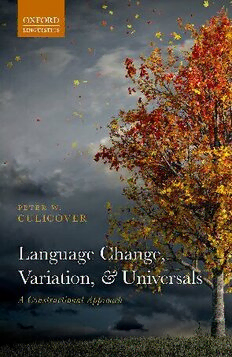Table Of ContentOUPCORRECTEDPROOF – FINAL,20/6/2021,SPi
Language Change, Variation, and Universals
OUPCORRECTEDPROOF – FINAL,20/6/2021,SPi
OUPCORRECTEDPROOF – FINAL,20/6/2021,SPi
Language Change,
Variation, and Universals
A Constructional Approach
PETER W. CULICOVER
1
OUPCORRECTEDPROOF – FINAL,20/6/2021,SPi
3
GreatClarendonStreet,Oxford,OX26DP,
UnitedKingdom
OxfordUniversityPressisadepartmentoftheUniversityofOxford.
ItfurtherstheUniversity’sobjectiveofexcellenceinresearch,scholarship,
andeducationbypublishingworldwide.Oxfordisaregisteredtrademarkof
OxfordUniversityPressintheUKandincertainothercountries
©PeterW.Culicover2021
Themoralrightsoftheauthorhavebeenasserted
FirstEditionpublishedin2021
Impression:1
Allrightsreserved.Nopartofthispublicationmaybereproduced,storedin
aretrievalsystem,ortransmitted,inanyformorbyanymeans,withoutthe
priorpermissioninwritingofOxfordUniversityPress,orasexpresslypermitted
bylaw,bylicenceorundertermsagreedwiththeappropriatereprographics
rightsorganization.Enquiriesconcerningreproductionoutsidethescopeofthe
aboveshouldbesenttotheRightsDepartment,OxfordUniversityPress,atthe
addressabove
Youmustnotcirculatethisworkinanyotherform
andyoumustimposethissameconditiononanyacquirer
PublishedintheUnitedStatesofAmericabyOxfordUniversityPress
198MadisonAvenue,NewYork,NY10016,UnitedStatesofAmerica
BritishLibraryCataloguinginPublicationData
Dataavailable
LibraryofCongressControlNumber:2021931013
ISBN 978–0–19–886539–1
DOI:10.1093/oso/9780198865391.001.0001
PrintedandboundinGreatBritainby
ClaysLtd,ElcografS.p.A.
LinkstothirdpartywebsitesareprovidedbyOxfordingoodfaithand
forinformationonly.Oxforddisclaimsanyresponsibilityforthematerials
containedinanythirdpartywebsitereferencedinthiswork.
OUPCORRECTEDPROOF – FINAL,20/6/2021,SPi
Contents
Acknowledgments ix
Preface xi
ListofAbbreviations xv
PART I. FOUNDATIONS
1. Overview 3
1.1 Theproblem 3
1.2 Constructions 9
1.2.1 Basics 9
1.2.2 Constructionsarenotderivations 12
1.3 Antecedents 14
2. Constructions 16
2.1 Introduction 16
2.2 Whatagrammarisfor 16
2.3 Aframeworkforconstructions 19
2.3.1 Representingconstructions 19
2.3.2 Licensing 27
2.3.3 Linearorder 28
2.4 Appendix:Formalizingconstructions 31
2.4.1 Representationsontiers 31
2.4.2 Connectionsbetweentiers 36
2.4.3 Licensingviainstantiation 36
3. Universals 41
3.1 ClassicalUniversalGrammar 41
3.1.1 Coregrammar 42
3.1.2 Parameters 44
3.1.3 UGandemerginggrammars 46
3.2 Anotherconceptionofuniversals 50
3.3 Onthenotion‘possiblehumanlanguage’ 53
3.3.1 Possibleconstructions 53
3.3.2 Anexample:Negation 56
3.3.3 Anotherexample:Theimperative 61
3.4 Againstuniformity 66
4. Learning,complexity,andcompetition 68
4.1 Acquiringconstructions 68
OUPCORRECTEDPROOF – FINAL,20/6/2021,SPi
vi contents
4.2 Constructionalinnovation 75
4.3 Constructionsincompetition 77
4.3.1 Multiplegrammarsvs.multipleconstructions 78
4.3.2 Definingcompetition 81
4.3.3 Whendoweactuallyhavecompetition? 86
4.4 Economy 87
4.4.1 Representationalcomplexity 88
4.4.2 Computationalcomplexity 90
4.4.3 Interpretivecomplexity 96
4.5 Simulatingcompetition 100
4.6 Summary 106
PART II. VARIATION
5. Argumentstructure 111
5.1 Introduction 111
5.2 Argumentstructureconstructions(ASCs) 112
5.2.1 Devices 112
5.2.2 CSfeatures 118
5.3 Differentialmarking 120
5.3.1 Differentialsubjectmarking 120
5.3.2 Differentialobjectmarking 130
5.4 Modelingdifferentialmarking 133
5.4.1 AcquisitionofASCs 134
5.4.2 Simulation 139
5.5 Summary 144
6. Grammaticalfunctions 145
6.1 Introduction 145
6.2 Thenotionof‘subject’ 146
6.3 MorphologicallyrichASCs 147
6.3.1 PlainsCreeargumentstructure 148
6.3.2 Incorporation 152
6.3.3 ComplexityinASCs 156
6.4 Splitintransitive 158
6.5 Theemergenceofgrammaticalfunctions 160
6.6 Summary 165
7. A(cid:4515)constructions 166
7.1 Foundations 166
7.2 DoingA(cid:4515)work 169
7.2.1 Gapsandchains 169
7.2.2 Relatives 174
7.2.3 Topicalization 175
OUPCORRECTEDPROOF – FINAL,20/6/2021,SPi
contents vii
7.3 Scopeinsitu 177
7.3.1 Wh-in-situ 178
7.3.2 Insituinpolysynthesis 180
7.3.3 Otherinsitu 182
7.3.4 Cryptoconstructionalinsitu 183
7.4 ExtensionsofA(cid:4515)constructions 183
7.5 TowardanA(cid:4515)constructionaltypology 189
7.6 Summary 194
PART III. CHANGE
8. ConstructionalchangeinGermanic 197
8.1 Introduction 197
8.2 BasicclausalconstructionsofModernGerman 198
8.2.1 Initialpositionintheclause 200
8.2.2 Positionofthefiniteverbinthemainclause 202
8.2.3 Positionoftheverbinasubordinateclause 203
8.2.4 Positionoftheverbinquestions 203
8.3 ThedevelopmentofEnglish 204
8.3.1 Thepositionoftheverb 205
8.3.2 The‘loss’ofV2inEnglish 208
8.3.3 Thelossofcasemarking 213
8.4 ThedevelopmentofModernGermanfromOldHighGerman 215
8.5 Verbclusters 219
8.6 Conclusion 223
9. ChangesoutsideoftheCCore 225
9.1 Englishreflexives 225
9.1.1 Reflexivityinconstructions 225
9.1.2 Variationandchangeinreflexiveconstructions 227
9.2 Auxiliarydo 230
9.2.1 Theemergenceofdo 230
9.2.2 Thespreadofdo 234
9.3 Prepositionstranding 235
9.3.1 Whyp-stranding? 235
9.3.2 P-passive 237
9.3.3 Coercion 239
9.4 Conclusion 241
10. Constructionaleconomyandanalogy 242
10.1 Theelementsofstyle 244
10.2 Analogy 249
10.2.1 Maximizingeconomy 250
10.2.2 Routines 252
10.2.3 Purestyle 257
OUPCORRECTEDPROOF – FINAL,20/6/2021,SPi
viii contents
10.3 Beyondparameters:Capturingthestyle 262
10.3.1 Baker’sPolysynthesisParameter 262
10.3.2 Greenberg’suniversals 264
10.3.3 Non-Greenbergianuniversals 267
10.4 Summary 272
11. Recapitulationandprospects 274
References 279
LanguageIndex 309
AuthorIndex 311
SubjectIndex 316
OUPCORRECTEDPROOF – FINAL,20/6/2021,SPi
Acknowledgments
This book has been a long time in the making, and has been profoundly
influencedbymanypeople.Asalways,thankstoRayJackendoffandSusanne
Winkler for their friendship, collegiality, advice, and support. Jack Hawkins
read several early versions of the manuscript and generously shared his
insights—theycanbeseenthroughout.IamverygratefultoJeffersonBarlew
for the formal description of the constructional framework developed as
part of our collaboration on minimal constructions, which appears in the
AppendixtoChapter2andisbasedonBarlew&Culicover(2015).AndIowe
a tremendous debt to Giuseppe Varaschin, who read the entire manuscript
in various incarnations and made countless detailed and constructive
suggestions, virtually all of which have been incorporated into the current
version.
Thanks also to Brian Joseph and Noah Diewald, from whom I learned so
much in the course of our discussions in our Cree Reading Group, to Greg
Carlson,AshwiniDeo,AdeleGoldberg,BjörnKöhnlein,AndrewMcInnerney,
Rafaela Miliorini, Lorena Sainz-Maza Lecanda, Richard Samuels, Yourda-
nis Sedaris, Andrea Sims, Shane Steinert-Threlkeld, Elena Vaiksnoraite, and
Joshua Wampler for stimulating discussions on a range of topics, to Philip
MillerforhelpfulcommentsonthematerialinChapter3andforhisgeneral
perspective on constructional approaches to grammar, to Afra Alishahi for
our collaboration on the simulation of change in argument structure con-
structions,toAndrzejNowakforourcollaborationonlanguagechange,and
toMarianneMithunforhelpfulinsightintoactive-stativelanguages.Thanks
to Zoe Edmiston, whose interest in Plains Cree stimulated my own, and to
MortenChristiansenandNickChaterforgivingmetheopportunitytowrite
theforewordtotheirrecentbookandtothinkfreshlyaboutthefoundations
oflinguistictheory.
Iamespeciallyindebtedtoseveralanonymousreviewers,whoseconstruc-
tive suggestions have pointed to a rethinking of this book in ways that have
led to significant improvements. Of course, any errors and deficiencies that
remainaremyresponsibilityalone.
TheDepartmentofLinguisticsandTheOhioStateUniversityawardedme
aSpecialAssignmentintheAutumnof2016,whichmadeitpossibleformeto

